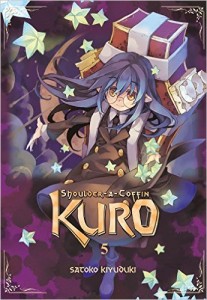By Satoko Kiyuduki. Released in Japan as “Hitsugi Katsugi no Kuro – Kaichu Tabi no Wa” by Houbunsha, serialized in the magazine Manga Time Kirara. Released in North America by Yen Press. Translated by Sheldon Drzka.
It is always lovely, especially in this age of experiencing media whose endings turn out to be trainwrecks, to see a series get it absolutely right. Everyone who has been reading the Kuro books should be absolutely satisfied by this ending, which wraps up everything we’d like to see and is probably the closest to a happy ending that this series was ever going to get. Indeed, this is lampshaded by a dream sequence showing us the Golden Ending of sorts, with Kuro cured and back to working for Sen, and you realize that no, you can’t just have that. It would ruin the story. And Kuro has been all about people’s stories, both in the reader collecting then as she and the kids make their journey, and also her own self-discovery, which also comes to a head here as she confronts Hifumi for the last time. But in the end, it’s Nijuku and Sanju who take the biggest steps, moving forward in a way that’s impossible for everyone else.
This is a volume that looks back as well as looking forward, especially in a chapter where Emily, a reporter trying to track down Kuro, comes across everyone else that Kuro’s come across on her journey, and what starts off with her terrifying ideas of the gender-ambiguous, vampiric Kuro and her beast-like children ends up being a series of interviews about how much Kuro, Nijuku and Sanju changed everyone they came into contact with. Including Emily, who never does get to meet Kuro but now desperately wants to, having seen just how much she’s affected everyone. That said, the first half of the book also presages the confrontation midway through, as Kuro’s creeping blackness, which we saw affecting Sanju last volume, is getting worse and worse. And then there’s Hifumi, who is having an identity crisis but also knows what she wants – those two kids.
The final half of the volume ends in a string of attempts at self-sacrifice, as Kuro and Hifumi confront each other, Hifumi in an effort to get to the two girls and Kuro in an effort to stop her, which pretty much involves trying to absorb her. This goes about as well as you’d expect, and between the two of them we get tragedy and realization… as well as a bit of closure, which is bittersweet but still has some sweetness in it. Kuro and Hifumi have always had that connection between them, and this merely reinforces it. In the end, though, neither one of them can be the ones to give Nijuku and Sanju a future – they have to make their own choice. Which they do, and it’s innocent and also sort of impossible and incredibly odd and ambiguous. Which is this entire manga in miniature, really.
This manga has been going for over ten years, with many stops and starts along the way, and another entire series by the same author (GA Art Design Class) in between. It’s a journey that will sound familiar to anyone who’s followed the title character, whose meandering was much the same. The author says there may be an eighth volume of short stories coming soon, but I wouldn’t hold your breath. Till then, though, enjoy what may be a perfect ending to this excellent series.



